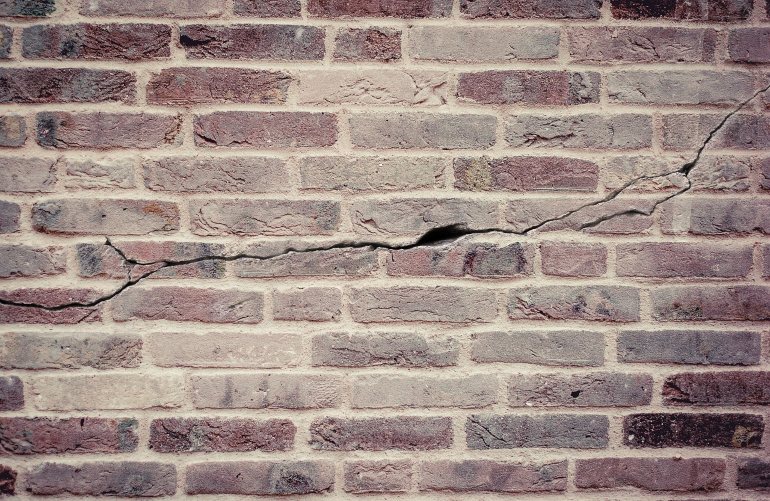Causes, checks, FAQs, avoiding and repairs
Subsidence is a serious issue that can significantly impact the stability and value of your property. Understanding the signs of subsidence, causes and preventative measures can help you manage and mitigate the risks associated with subsidence. This guide will cover the key aspects of subsidence, including its causes, how to identify early signs, and what to do if your property is affected.
What are the Causes of Subsidence?
Subsidence occurs and property sinks when the ground beneath a building loses its ability to support the structure, leading to a downward movement. Several factors can contribute to subsidence:
- Soil Type: Certain soils, such as cohesive soils like clay, shrink and swell with changes in moisture content, making them more prone to subsidence.
- Tree Roots: Trees and large shrubs can extract significant amounts of moisture from the soil, causing it to dry out and shrink.
- Drains and Gutters: Leaking drains and gutters can wash away or erode soil, reducing its stability. Don’t ignore signs of damp.
- Poorly Compacted Ground: If the ground wasn’t properly compacted when the building was constructed, it could settle over time, leading to subsidence.
- Historical Factors: Older buildings may suffer from historic subsidence due to changes in ground conditions over many years.
What are the Main Signs of Subsidence?
Recognising the early signs of subsidence can prevent further damage and costly repairs. Here are the main indicators:
- Cracks in Walls: Look for diagonal cracks that are wider at the top than the bottom, especially around prone areas like doors and windows.
- Doors and Windows Sticking: Difficulty in opening or closing doors and windows can indicate that the frames have become distorted.
- Uneven Floor Surfaces: Floors that are not level or have begun to slope can be a sign of subsidence.
- Wallpaper Creasing: If wallpaper crinkles, creases or tears without any evident cause, it could be due to underlying wall movement.
- Gutters and Drains: Issues with gutters and drains, such as misalignment or leaks, can indicate subsidence.
FAQ: How Long Does Subsidence Take to Appear?
The appearance of houses with subsidence can vary. It can develop slowly over many years or become noticeable within a few months, especially after significant weather events such as prolonged droughts or heavy rains. Historical subsidence might already exist in older properties but remain dormant until new conditions trigger further movement.
How Can I Check for Subsidence?
To check for subsidence, you can perform a few basic inspections:
- Visual Inspection: Look for subsidence cracks in walls or ceilings, and around windows and doors. Ignore minor cracks or hairline cracks in your plaster which are known as settlement cracks.
- Check Floors: Use a spirit level to check if floors are even.
- Monitor Changes: Keep an eye on any cracks or sticking doors and windows over time. Marking the ends of cracks with a pencil can help track their progression.
For a more thorough assessment, consider hiring a professional:
- Building Survey: A detailed building survey by a qualified surveyor can identify subsidence issues and their extent.
- Structural Survey: A structural survey by a structural engineer can provide insights into the stability of the building’s foundations.
- Subsidence Survey: Specialist subsidence surveys focus specifically on identifying and diagnosing subsidence.
Avoiding and Repairs
You can prevent subsidence by managing the factors that cause it. Here’s how to reduce the risk:
- Tree Management: Plant trees away from buildings and regularly maintain existing ones to control root spread.
- Gutters and Drains: Ensure gutters and drains are in good condition and direct water escape away from the property.
- Soil Moisture: In dry periods, keeping the soil evenly moist can prevent shrinkage in clay soils.
- Foundations: Building on stable ground and ensuring foundations are deep enough can prevent future subsidence.
If your property has already been affected by subsidence, repair options include:
- Underpinning: Strengthening the foundations by extending them to a more stable layer of soil.
- Resin Injection: Injecting resin into the ground to fill voids and strengthen the soil.
- Innovative Solutions: Innovative techniques, like those provided by Geobear, offer less invasive and faster methods of stabilising the ground.
FAQ: What are Subsidence Warning Signs?
A subsidence warning is an alert issued by experts, often during periods of weather that increase the risk of subsidence. For example, prolonged dry spells can lead to drying and shrinking of clay soils, heightening the risk of subsidence. Being aware of these warnings can help homeowners take preventative actions to minimise damage.
Subsidence Insurance and Claims
Homeowners with subsidence issues can face significant repair costs. Having the right buildings insurance is crucial. Ensure your policy covers subsidence and check for any specific exclusions. If subsidence is identified, you can make a claim on your buildings insurance. A surveyor will typically assess the damage and the insurance company will decide on the coverage.
Expert Advice
When dealing with subsidence, expert advice is invaluable:
- Surveyor: A professional surveyor can provide a detailed assessment and recommend the best course of action.
- Structural Engineer: For significant structural damage, a structural engineer’s expertise is essential.
- Specialist Contractors: Engaging contractors with experience in subsidence repairs ensures the work is done correctly and efficiently.
How Can Blue Crystal Property Management Help?
At Blue Crystal Property Management, we understand the complexities and challenges that come with managing subsidence issues. Our comprehensive services ensure that your property is well-protected and maintained, minimising the risk and impact of subsidence.
- Regular Inspections: We conduct regular property inspections of your property to identify early signs of subsidence, such as cracks in walls, uneven floor surfaces, and sticking doors and windows.
- Professional Assessments: We can recommend qualified surveyors and structural engineers who can perform detailed building and structural surveys to diagnose subsidence and recommend appropriate actions.
- Preventative Maintenance: We manage and maintain gutters, drains, and surrounding vegetation to prevent common causes of subsidence. This includes ensuring proper soil moisture levels and addressing any drainage issues promptly.
- Expert Repairs: Should subsidence occur, we coordinate with experienced contractors to carry out necessary repairs, such as underpinning or resin injection, ensuring minimal disruption to your property.
- Insurance Support: We can assist with the buildings insurance claims process, ensuring that all necessary documentation is provided and liaising with insurance companies to secure coverage for subsidence-related damages.
- Tenant Communication: For rental properties, we maintain clear communication with tenants, informing them of any necessary inspections or repairs and ensuring they understand the signs of subsidence to report any issues promptly.
- Ongoing Monitoring: Post-repair, we continue to monitor your property to ensure that the subsidence has been effectively managed and that no further movement occurs.
By entrusting Blue Crystal Property Management with your property, you can rest assured that every aspect of subsidence management is handled with expertise and care. Our proactive approach helps prevent minor issues from becoming major problems, safeguarding your investment and maintaining the value and stability of your property.
Book your 30-minute complimentary property consultation by phone: 020 8994 7327 or email: pm@bluecrystallondon.co.uk.


